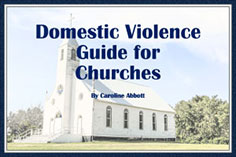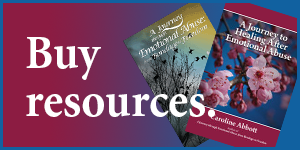In my last blog, I posed the question: “Will an abuse survivor ever be completely healed?” Sadly, the answer is no. Happily, you can move passed your past into a better future. But HOW can you do that? To answer that question, I would like to share the following excerpt from my book A Journey to Healing After Emotional Abuse:*
In his book, Mending the Soul,** Steven Tracy outlines a path toward healing childhood abuse. Tracy contends you cannot heal your past abuse until you are honest about it and truly feel the emotions of it. He notes that many childhood victims of domestic abuse, especially of sexual abuse, instinctively minimize and take the blame for the abuse they experienced. He says you will often hear adult survivors make statements such as, “My father didn’t really molest me; he just touched me inappropriately a few times.” Or, “Overall, my parents really took pretty good care of me.” Or, “My home wasn’t really as bad as others” or “No wonder my parents got so angry with me; I was a hard child to raise.” Tracy says the reason we do this is to protect ourselves from acknowledging our parents didn’t love us as they should have.
When we minimize the abuse we’ve experienced, we stay in denial and deaden our emotions to our past abuse.![]() Tweet This
Tweet This
Have you ever described an abusive event you’ve experienced in the same way you would give a weather report, i.e., with little to no emotion? When I first left my abusive husband, I laughed when I described his abuse of me, which made my friends very uncomfortable. This type of denial of our emotions keeps us in bondage to the trauma and prevents us from healing.
Eleanor D. Payson, M.S.W., agrees. In her book The Wizard of Oz and Other Narcissists: Coping with One-Way Relationships in Work, Love, and Family,*** Payson opines that our early traumas and unmet needs in childhood are not the most significant wounds we take with us into adulthood.
She says:
the greater wound is our lack of opportunity or support to process our feelings about those traumatic events. ![]() Tweet This
Tweet This
She says when a child experiences trauma, and is helped by a parental figure to talk about her feelings, she will be able to move forward with her “self ” intact. However, if she must pretend the trauma didn’t happen, or pretend she is not upset by it, and if she doesn’t get to talk about her true feelings, she will carry an unhealed scar into adulthood.
Here are the steps Steven Tracy outlines to heal from childhood abuse:
Step 1: Establish safety: Make sure you are no longer being abused before you begin this work. Check out Chapter 2, where I describe creating boundaries with your abuser. You may want to begin this work within the safety of a counselor’s office (see Chapter 6) or with a trusted friend.
Step 2: Choose to face the truth and feel: You won’t be able to immediately feel the emotions you may have spent many years trying to hide from and deny. However, you will have to decide you are willing to face what really happened to you and allow yourself to feel the emotions that surface.
Step 3: Tell—and feel—the story by writing your personal trauma narrative: Write a timeline of abusive events that happened to you, at what age, and by whom. You may want to enlist the help of supportive friends and family members who were there in your childhood to fill in events and dates you have forgotten, especially if your abuse occurred when you were very young, or if you have blocked much of it from your memory. Add the responses of family members and other caregivers. Often family members contribute to your trauma by their reactions. Did they blame you? Did they insist you cover up the abuse? Did they deny it happened?
You may find this step especially challenging. Often, families intimidate abuse victims to keep secrets, and you may feel disloyal recounting your past abuse. Christians often believe people should “put the past behind them, and look toward the future.” However, you cannot put the past behind you until you have looked at the truth of it and resolved the trauma.
Take a look at the story of Joseph in Genesis 37:1-36 and 42:1-50:21. Joseph’s brothers were jealous of him, captured him, and sold him as a slave. Many years later, Joseph became a powerful man in Egypt. His brothers went to Egypt to beg for food because there was a famine in their land. Ironically, Joseph was the man they had to ask for their food! Joseph recognized them, but they did not recognize Joseph. Before Joseph reconciled with his brothers, he put them through many trials to help them realize the sin they had committed toward him, which caused Joseph, as well as his brothers, emotional pain. When they finally repented of their sin, Joseph revealed his identity to his brothers, and they were able to reconcile.
Joseph could have reconciled with his brothers right away, denying the pain they caused him. Instead, he chose to be honest about their abuse, causing both his brothers and him to feel the pain of their actions. Only then could a true reconciliation occur.
Step 4: Identify the distortions and reclaim God’s original design: See CDV.org’s list of lies domestic violence teaches children about themselves. Think about which ones you have believed about yourself. Next, think about lies you have believed about God, such as, “I can’t trust Him,” “He doesn’t love me,” “God is disgusted with me,” “God is punishing me.” Finally, identify the lies you have believed about others. These could include, “If others really knew me, they would reject me,” “You can’t trust anyone; people will only hurt you,” “Men are all alike; all they want to do is use women,” “No decent man will ever want me.”
Step 5: Repent of deadness and denial: When you were a child, you found ways to cope with the abuse you suffered. This was a good and creative ability, and helped you survive. For example, if at age nine you looked at a spot on the wall to help you tune out your abuse, you should be congratulated for that. However, if as an adult in a non-abusive relationship you protect yourself by tuning out, stiffening, or fleeing intimacy, this is no longer protecting you. Instead, you are hurting those around you, isolating yourself, and not trusting God. When we try to shield ourselves from pain, we end up shielding ourselves from life, joy, and intimacy with God and others.
Step 6: Mourn the loss and dare to hope: In order to really heal, you must mourn your losses. I believe mourning is biblical and necessary for healing. In Matthew 5:4, Jesus says,
Blessed are those who mourn, for they will be comforted.
The Bible dedicates the entire book of Lamentations to mourning. When you have fully mourned, you can begin to hope, as Jeremiah did in Lamentations 3:22, 23:
Because of the Lord’s great love we are not consumed, for his compassions never fail. They are new every morning; great is your faithfulness.
As you truthfully face the pain your childhood abuse has caused you, both when it happened, and throughout your life, you can begin to see God face to face. God is the great healer. By taking our pain to Him, we can begin to be truly healed. Often, we might need a trained counselor to walk alongside us as we process our past traumas. To find a counselor in your area, click here.
Question: Have you minimized or denied the abuse you suffered as a child? If so, what would happen if you stopped denying your pain?
Healing from abuse is hard, and difficult. But it is worth it! I pray we will all stop denying our pain, and begin accepting it so we can move forward into healing.
May the Lord bless you today!
Caroline
* Abbott, Caroline A Journey to Healing After Emotional Abuse (Franklin, TN: Clovercroft Publishing, 2015) 86 – 89.
** Steven R. Tracy, Mending the Soul: Understanding and Healing Abuse (Grand Rapids, MI: Zondervan, 2005), 145.
*** Eleanor D. Payson, M.S.W., The Wizard of Oz and Other Narcissists: Coping with the One-Way Relationship in Work, Love and Family (Royal Oak, MI: Julian Day Publications), 80.



